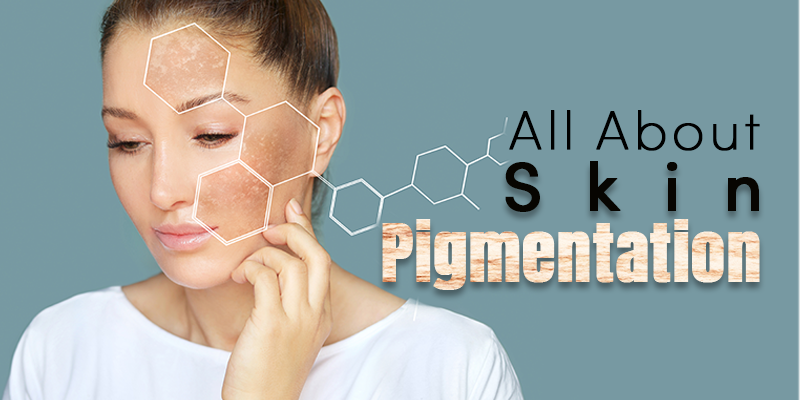Pigmentation is primarily known as the discoloration of the skin. The natural skin pigment which is known as “Melanin” is known to provide color to the skin, hair, nails, and eyeballs.
According to studies and research, In India, almost 80% of the population is known to suffer from the problem of pigmentation which makes it a staggeringly large issue.
When the cells which are responsible for creating melanin become damaged or inactive, it causes the problem of pigmentation. People get affected with different colored patches on the skin. In other cases, it is referred to as the complete absence of melanin from the skin.
If an individual’s body makes too much melanin, the skin usually tends to get darker. Some factors like pregnancy, Addison’s disease, and sun exposure are all some of the common factors which can make the skin darker. If the body makes too little melanin, an individual’s skin tends to get lighter.
Vitiligo is a pigmentation/skin condition which causes patches of light and dark skin. Albinism on the other hand is a genetic condition affecting a person’s complete skin and appearance.
A person with albinism may have absolutely no color, lighter than the normal skin color, or patchy and missing skin color. Infections, blisters and burns can also cause an individual to have a lighter skin when it is re-growing.
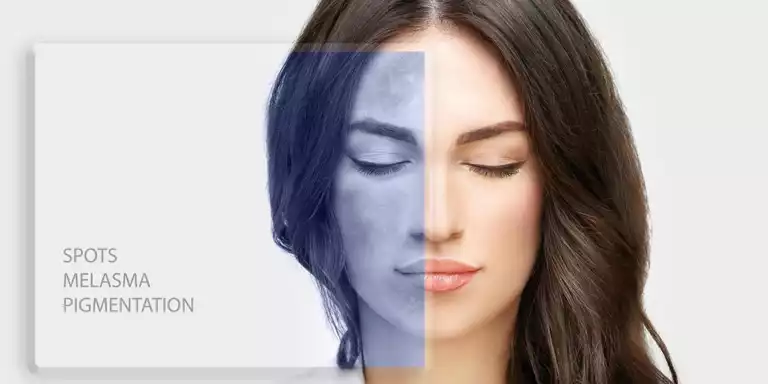
Let’s take a look at the data of Indian skin colorimetric classification in the skin color volume.
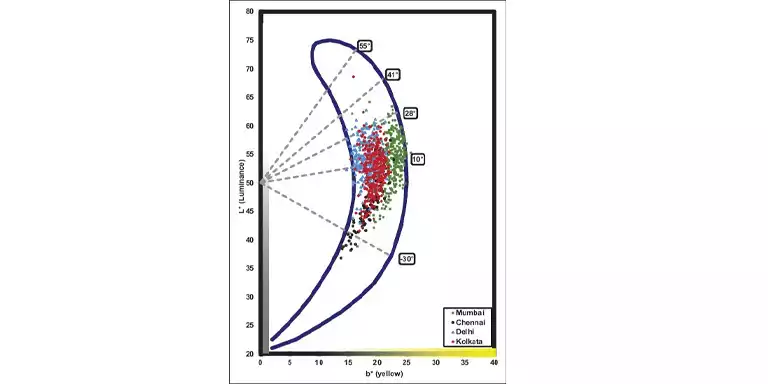
(Credit: National Library of Medicine)
An Overview Of Pigmentation –
Pigmentation can happen due to various factors. In some cases, an individual might experience this issue right from their birth, while in others the absence of melanin might gradually develop in the coming years.
Needless to say, people often fail to diagnose pigmentation correctly. They take it as disease based on appearance.
Pigmentation can range from severe factors like –
- Albinism
- Vitiligo
- Solar lentigines
- Freckles
- Melasma
- Post-inflammatory hyperpigmentation.
Human skin color ranges from the darkest of browns to an extremely pale and white color. This wide range in itself is the ultimate proof that there is no “one” color that fits everyone.
Genetics, heritage, area, climatic conditions, and many more factors are responsible when it comes to the various shades of an individual.
However it can also be caused by several underlying issues. These complications, if not treated on the correct time, can cause the pigmentation issue to get out of hand and in some cases cause skin cancer or melanoma.
It’s extremely rare that a person can suffer from “Cancer” due to skin pigmentation.
Dermatologists and doctors throughout the world recommend getting a checkup at least once a month to detect any changes in the body that could lead to cancer. Patients who especially have a family history of diseases like cancer and other skin issues should take special care to keep oneself in check.
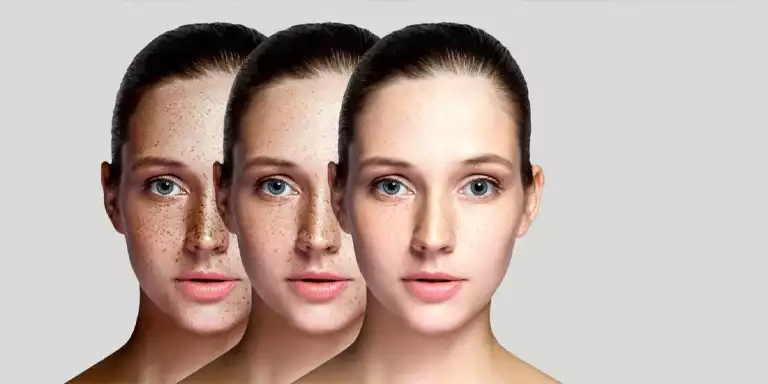
What Is Pigmentation?
In clinical terms, pigmentation refers to the coloring of the skin, hair, eyebrows, mucous membranes, and retina of the eye. It is due to the deposition of a specific kind of pigment called melanin. Produced by specialized bunch of cells known as melanocytes.
Other pigment-related terms include hyperpigmentation (too much pigment), hypopigmentation and under pigmentation (too little pigment), and depigmentation (loss of complete pigment). Also known as Albinism.
Although there are various different degrees of different kinds of albinism and other forms of pigmentation, the broad term remains the same, i.e. the partial or complete absence of Melanin.
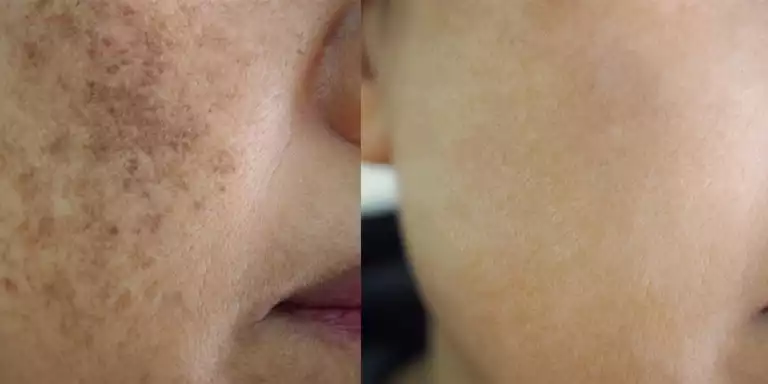
What Causes Pigmentation?
It has numerous factors and will be different for everyone. Pigmentation disorders are commonly diagnosed, evaluated, and treated through various professionals. Some of the most common pigmentation disorders include post inflammatory hyperpigmentation, melasma, solar lentigines, ephelides (freckles), and café au lait macules.
These conditions are generally mild but can be distressing to some patients. It requires proper research and diagnosis. Appropriate dermatologic history, skin examination, and biopsy can help in excluding melanoma and its precursors. Treated with topical agents, chemical peels, cryotherapy, light & laser therapy, etc.
Hypopigmentation disorders include vitiligo, pityriasis Alba, tinea versicolor, and post inflammatory hypopigmentation.
Treatment of vitiligo depends on the distribution and extent of skin involvement. This includes treatment via topical corticosteroids and calcineurin inhibitors.
Patients with stable, self-limited and a lower capacity of vitiligo may be candidates for surgical grafting techniques, whereas those with the extensive version of the disease may be candidates for depigmentation therapy to make the skin tone appear more even. Other hypopigmentation disorders may improve or resolve with treatment of the underlying condition.
It commonly encountered in various primary care practices. They are usually easily distinguishable based on the appearance and location. It may also be necessary to perform a skin biopsy to exclude melanoma and its other precursors.
Some disorders result in a cosmetic or psychological concern to the patient, necessitating evaluation and treatment. A proper diagnosis allows the physician to carry on the appropriate skin treatment, while providing reassurance and appropriate referral.
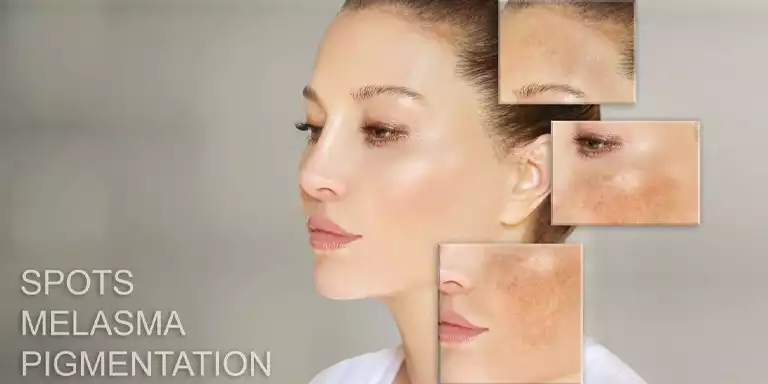
What Are The Different Types Of Pigmentation?
There are several different types of pigmentation. Understanding the underlying cause for it, helps to decode better as to what is causing it. Let’s take a look at some possible common signs and types of pigmentation that we probably push aside or tend to ignore.
- Hypo-pigmentation – A decrease in melanin production which makes the skin whiter than usual is also known as Hypo-pigmentation. This often shows up in the form of patches or white spots that people tend to overlook.
- Vitiligo – Vitiligo is a type of hypo pigmentation, where smooth white patches are present on the skin. This happens due to the damaged melanin producing cells of the body. Although there are no treatments for vitiligo. and easily covered with the help of certain cosmetics.
- Albinism – Albinism is also known as the complete absence of melanin producing cells from the body. This rare and inherited disorder causes lack of pigmentation in the hair, and eyes as well.
- Hyperpigmentation – Hyperpigmentation is when certain patches of skin become darker than the surrounding skin due to an increased deposition of the melanin in the dermal or epidermal layer.
- Melasma – Melasma occurs when there is an uneven or unequal production of melanin in the skin which results in brown and black patches. Exposure is the main culprit. A combination of other medical issues might also contribute to the disease.
- PIH – Post inflammatory Hyperpigmentation is a discoloration of the skin which happens due to inflammation. PIH or Post inflammatory hyperpigmentation sometimes appear as a pink, red, brown or black spot, depending upon one’s skin tone. Triggered by hormones, acne, a wound, or rash that causes inflammation of the skin.
- Peri-orbital Melanosis – This condition commonly appears as dark circles. While it can be hereditary, in a lot of cases, extreme straining on the eye can elevate the issue further.
- Freckles – Although the current beauty industry has started flaunting freckles, one can easily make them out from its distinctive brown spot. It is hereditary in nature, but an extensive sun exposure can make the flare up much worse.
- Photo melanosis – This problem shows up as a patchy pigmentation on the neck, back and arms. Mostly caused due to long hours of sun exposure.
- Sunburn – Commonly known as tanning, sunburn shows up as a red rash in the initial phrase. However if ignored for a long time, it can also convert into skin cancer in some rare cases.
- Age Spots – Age spots are also known as liver spots or lentigines. Caused by skin damage from long hours of sun exposure. These spots may appear on the face, neck, décolleté and arms. The correct form of prevention from an early age is the only way to avoid developing these liver/age spots.
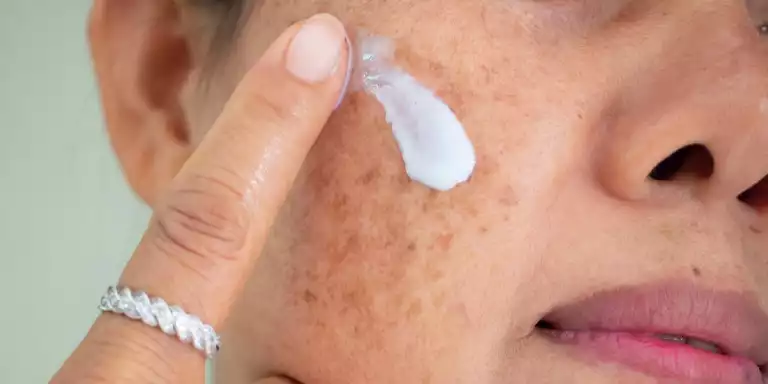
What are the different causes for Pigmentation?
There are various different causes of hyperpigmentation and these vary from person to person. Sun exposure, genetics and hereditary factors are responsible for this. Today, let’s look at some of the causes of pigmentation.
- Long hours of Sun exposure – Long hours of sun exposure might cause extensive damage to the skin. This can also cause one of the deadliest forms of skin cancer known as Melasma in the long run. It is always important to pile on a good amount of sunscreen before stepping out.
- Aging – In some cases, aging can be another major factor which causes spots and discoloration on the face. Investing in a good skincare routine after consulting a dermatologist is a good option to keep the problem at bay.
- Hormonal fluctuations – Hormonal fluctuations are a major part of discoloration and pigmentation. These blue, black, brown and red spots might show up on the skin for various medical reasons. If not treated properly, they might leave a stubborn scar which does not fade away easily.
- Existing skin conditions – Existing skin conditions like eczema, rosacea, psoriasis and more can harm the skin into developing hyperpigmentation and spots which take a long time to fade away.
- Wound healing – Sometimes, when the tissues heal from any existing or fresh cut in our body, then it leaves behind a trail of hardened skin and tissues. These can leave behind a semi-permanent to permanent scar. However various over the counter medicines are currently available to remove such marks.
- Stress – Stress can cause an individual to break out on their entire body. Sometimes it shows up in the form of Acne on the forehead, back, cheek, chin and more. Hormonal acne caused by stress take a long time to heal. If not cared for properly, they tend to leave a mark behind.
- Incorrect Skin Care regimen – An incorrect skin care regimen can also bring down the quality of the skin while causing allergic reactions, rashes and breakouts. This can cause scarring on the skin which refuses to fade away with time if ignored.
- Heat from pollutants/cooking – Heat and smoke which emerges from the pots and pans while cooking in the kitchen can also cause the skin to get dull, dry and irritated. This can cause pigmentation issues in the long run. Taking care of the skin with a timely routine can help in avoiding this problem.
- Skin bleaching – Skin bleaching is usually not recommended as it burns the upper layer of the skin which causes allergic reactions. It might also cause the skin to become patchy and rough along with discoloration.
- Air pollution – Air pollution is another one of the reasons as to why people get damaged, dry and dull skin. The toxic smoke, small particles in the air are all contributors to pigmentation. Applying a good quality sunscreen is what helps to protect the skin.
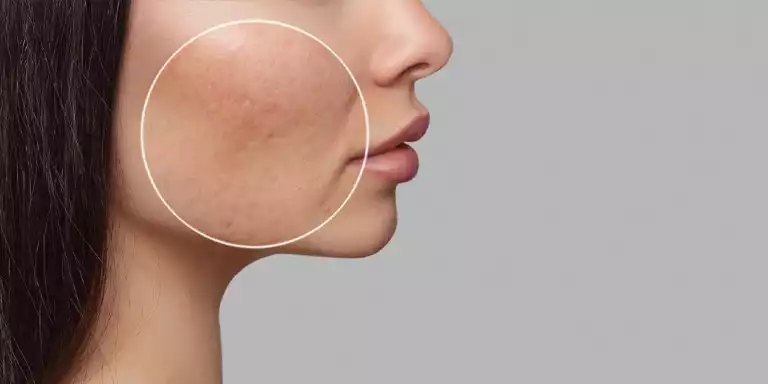
How to prevent skin pigmentation?
Completely removing skin pigmentation is not possible unless an individual opts for laser therapy. We need to take some precaution to minimize these spots.
Some ways to prevent Pigmentation.
- Avoid direct sunlight – Avoiding direct sunlight is a great way to prevent pigmentation. The harmful ultraviolet rays do not penetrate the skin and hence it does not cause patchiness or brown spots. Always cover up yourself with scarves, dupattas, sunscreen, hats, sunglasses etc. to avoid pigmentation.
- Incorporate Vitamin-C in your skincare routine – Vitamin-C acts as an excellent component which fades away any brown spots, patchiness, dull skin or pigmentation. It rejuvenates the overall appearance of the skin while making it glowing and supple.
- Incorporate a good quality SPF – A good quality sun protection with a high amount of SPF will protect your skin from the ultraviolet rays. Sunscreen should be repeated after every 3-4 hours in order to make it work properly.
- Limiting touching your face – Touching your face constantly to pop pimples and dig out blackheads is not a wise decision. It will cause scarring and hyperpigmentation. Applying medicated ointments to treat the issue instead is a wiser decision.
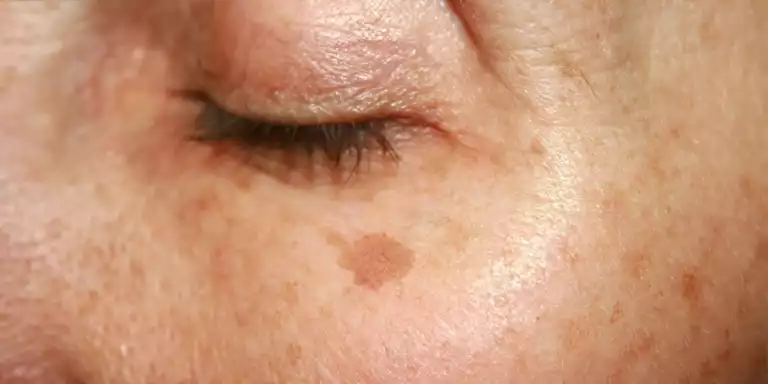
What Are The Different Methods For Treating Skin Pigmentation?
Pigmentation is basically when the patches of skin become darker than the rest of the body. This physical condition might appear anywhere on the face or the rest of the body. Fortunately there are different treatments available which can help in treating pigmentation. Let’s take a look at some medicinal and home based DIY’s which will help in treating skin pigmentation and hyperpigmentation.
- Use Topical creams/ointments – Many topical ointments which help in lightening the skin such as azelaic acid, corticosteroids, kojic acid, hydroquinone, vitamin-c and retinoid like tretinoin can be helpful in treating pigmentation.
- Opting for a cosmetic procedure – A cosmetic procedure includes various options depending upon the severity and budget. Some of these options are – microdermabrasion, chemical peel, laser therapy and intense pulsed light.
- Chemical Peels – Before using a chemical peel one should be extremely careful. It can easily react with extremely sensitive skin types. A patch test is extremely important to see if it is reacting with the skin. Due to the harsh nature and component of the formula, it might dissolve and fade the spots easily but a good follow up skincare routine is essential to avoid damaging the skin.
- Medi-Facials – Medicated facials are also known as “Medi-facials.” These facials are important for a sensitive to mature skin type. It boosts the elasticity and collagen production by perforating deep into the layers of the skin. It has a superior and longer stay time as compared to a normal salon facial.
- Mesotherapy – Developed by a French doctor known as Michel Pistor, “Mesothrapy” is a French rejuvenation technique that uses micro injections of vitamins, enzymes, antioxidants, plant extracts and other nutrients to rejuvenate, tighten, and remove the pigmentation problem from the skin. It also improves hair quality, as well as removes the excess fat.
- Micro-needling with PRP- Micro Needling with PRP is also popularly known as the vampire facial. In it, customer’s blood is drawn in a syringe, extracted platelets. Then further applied back onto the face with the help of tiny needles. This leaves redness and swelling on the face but usually resolves in a week to reveal healthy and rejuvenated skin without discoloration.
- Laser Peel – A laser peel (resurfacing) treatment uses targeted beams of light to reduce hyperpigmentation. There are two types of lasers: ablative and non-ablative. Ablative lasers are the most intense, and they involve removing layers of your skin. Non-ablative procedures, on the other hand, target the dermis to promote collagen growth and tightening effects. Ablative lasers are stronger, but they may cause more side effects. Both destroy elements in your skin to ensure that new skin cells grow back tighter and more toned.
- IPL Therapy – Intense pulsed light (IPL) therapy, aka photo facial, is a way to improve the color and texture of your skin without surgery. It can undo some of the visible damage caused by sun exposure — called photo aging. You may notice it mostly on your face, neck, hands, or chest. IPL may help if you have red, brown, or splotchy skin because of a health condition.
- Microdermabrasion – Microdermabrasion is a minimally abrasive instrument which is used to gently sand the skin, which removes the thicker, uneven outer layer which in turn reduces pigmentation and discoloration. This type of skin rejuvenation is used to treat light scarring, discoloration, sun damage and stretch marks.
- Photodynamic Treatment – Photodynamic therapy (PDT) is a medical treatment that utilizes a photosensitizing molecule (frequently a drug that becomes activated by light exposure) and a light source to activate the administered drug.
- LED Light treatment – Green LED Therapy is used to treat dilated capillaries, sagging skin around the eyes, under eye circles, hyperpigmentation and sun spots. Blue LED light has been proven to have powerful antibacterial properties that have the ability to kill the acne causing bacteria.
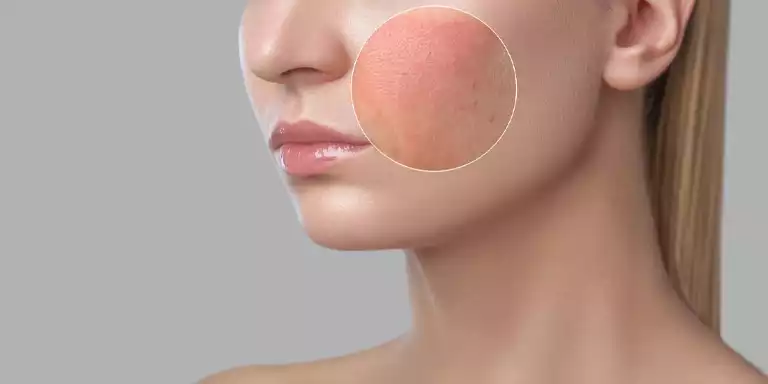
What Are Some Oral Medications For Treating Pigmentation?
Oral medications are growing by leaps and bounds when it comes to treating Pigmentation. From synthetics to natural pills and tablets, various medications are available for an individual to try on. Pigmentation varies hugely from person to person. It can be severe in some cases and muted in others. The dosage of an oral medication depends on the seriousness and skin type of the patient. Today let’s take a look at some oral medicines which can be taken by an individual to treat pigmentation.
- Melatonin – Secreted by the pineal gland, the hormone melatonin is a potent antioxidant and free-radical scavenger which stimulates several antioxidant enzymes like superoxide dismutase, glutathione reductase, and glutathione peroxidase. Oral and topical melatonin is extremely efficient in treating melasma.
- Glutathione – One of the most powerful antioxidants produced by the human body, Glutathione is a tripeptide of glutamate, cysteine, and glycine. It has proven to be one of the most efficient topical medicines for skin lightening which in turn reduces pigmentation.
- Cysteamine – Cysteamine hydrochloride is naturally produced in the human body which can be effectively used in treating the problem of pigmentation. It also consists of the amino acid “L-cysteine.” Controlled dosage under expert advice can be effective in treating pigmentation.
- Pigment correcting serum – Pigment-correcting serum contains TA, tetrapeptides, plankton extracts, niacinamide, phenylethyl resorcinol, and undecylenoyl phenylalanine. It helps in dealing with melasma and post-inflammatory hyperpigmentation.
- Methimazole – Methimazole is used to treat patients with hyperthyroidism and has been shown to have a rapid decrease in the issue of pigmentation when applied topically in patients.
- Flutamide – This particular medicine is a nonsteroidal antiandrogen that blocks the action of endogenous and exogenous testosterone by binding to the androgen receptor. It has proven to work on patients with skin hyperpigmentation.
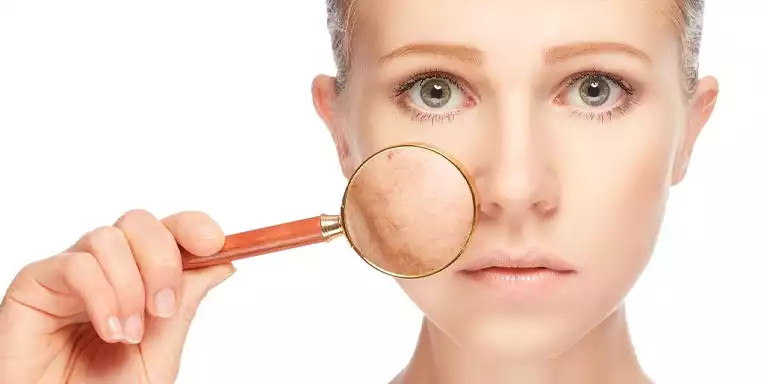
What Are Some Home Remedies To Treat Hyperpigmentation?
Pigmentation is a wide umbrella under which many categories appear. Easily resolved by some home remedies.
Let’s have a look at some of the factors which contribute to the removal of pigmentation via some effective home remedies.
- Usage of Tomato on the skin – Usage of Tomato on the skin is a great way to reverse any damage or discoloration which has happened due to harsh sunlight. Cut a tomato in half and rub it all over your face, neck, elbows and affected areas. Keep it on for 15-20 minutes before washing it off with regular temperature water.
- Yogurt and Honey – Yogurt and Honey are some of the most commonly found ingredients in every individual’s kitchen. This mixture helps to even out any discoloration while smoothing the skin.
- Lemon Juice – Lemon Juice is known for its astringent properties. However it is not wise to use it directly on the skin as it can cause rashes, redness, itching and burning. Always mix it in with your regular face pack before application.
- Chickpea Flour – Chickpea Flour which is also known as besan in hindi is a common ingredient which helps to clean, nourish and remove impurities. This staple kitchen ingredient remedy has proven effective at removing sun spots and pigmentation for generations.
- Rice Flour – Rice Flour is another understated yet excellent option to try out. Helps in cleaning the face and body without any gunk. An excellent option if you have pigmentation on your arms and legs.
- Crushed Oats and Banana – Loved by celebrities like Katrina Kaif, a simple face pack like crushed oats with banana is a great option for people who are looking to restore some glow into their skin which has turned dull and dry due to pigmentation.
- Aloe Vera Gel – Aloe Vera Gel is cheap, easily available and a great natural alternative to combat pigmentation. It soothes, nourishes, de-tans and calms down the skin in a jiffy.
- Turmeric – Turmeric is that staple ingredient which acts as an anti-fungal and anti-bacterial natural alternative. A pinch of it into any face mask will work wonders to clear up skin pigmentation.
- Vitamin E – Vitamin E capsules are a wonderful way of incorporating some moisture into the skin by stopping the external water loss. Mixed it with facial and scrubs for sensitive and dry skin.
- Beetroot – One of the most gorgeous and alternative natural options for a cheek blush is that of a beetroot. It makes the skin glow naturally by adding just the perfect flush of color without damaging the skin. It also shows up wonderfully on a skin which is prone to dark spots and pigmentation.
- Green Tea – Green Tea is a great way to calm down any pigmentation which is especially dark around the mouth and eyes. It soothes any inflammation and irritated skin which helps with gradually fading away any hyperpigmentation.
- Coffee Grinds – Coffee Grinds act as a wonderful natural scrub which is gentle on the skin. It exfoliates, removes any impurities and helps in lightening discoloration and sun spots from the skin.
- Milk – Milk has several antioxidant, anti-inflammatory, calming, soothing and healing properties. When mixed with kitchen staples like chickpea flour, lemon juice and turmeric it can form a wonderful face pack called “Ubtan”. Trusted by generations for treating discoloration and hyperpigmentation.
- Red Onion – Red onion extract (Allium Cepa) is found in many scar and skin lightening creams. It is beneficial in treating hyperpigmentation and hence look for skincare products which have this specific infusion.
- Black Tea – Black Tea water is supposedly used to lighten and brighten the skin. It works as an effective remedy in reducing skin pigmentation. Use it as a toner before applying moisturizer to lighten pigmentation.
- Red Lentils paste (Masoor Dal) – The paste of masoor dal or red lentils is used to effectively lighten, brighten and smoothen the skin. Although if you are someone who has a sensitive skin type then a patch test is necessary to avoid any inflammation.
- Apple Cider Vinegar – Apple cider vinegar is used due to its astringent properties. It also contains acetic acid which lightens skin pigmentation when mixed with equal parts of water.
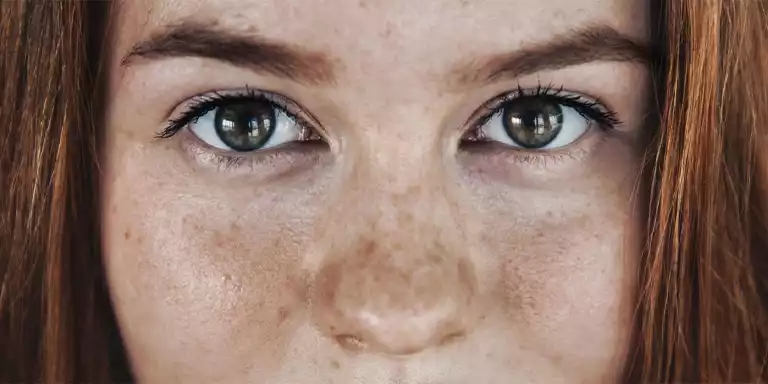
What Are Some Chemical Treatments For Skin Pigmentation?
Chemical Treatments have long lasting, effective results and are hence much harsher on the skin. It is advisable to not start any kind of chemical peel, exfoliator or other lightening product before consulting a dermatologist. However, if you are one of those individuals who are suffering from a long lasting case of chronic hyperpigmentation then these peels and chemical medicines might work out for you.
Some common over the counter lightening products include properties like –
- Licorice extract
- N-acetylglucosamine
- Vitamin B-3 (niacinamide)
(Skin Diaries – Skin Pigmentation By Dr. Rasya Dixit)
Other chemical lightening products for hyperpigmentation include the usage of facial acids. Very popularly found in beauty and drug stores.
- Alpha hydroxy acids
- Glycolic
- Lactic
- Citric
- Malic
- Tartaric acid
- Azelaic acid
- Kojic acid
- Salicylic acid
- Vitamin C (in the form of l-ascorbic acid)
These acids can also effectively remove almost 90% of hyperpigmentation on lighter and fairer skin tones. If used over a longer period of time then it can almost fade away the issues of sun damage and sun spots which can later on turn into more serious issues of melasma.
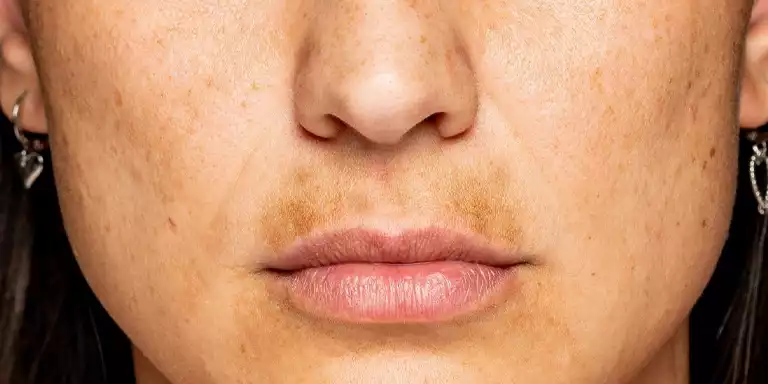
What Is The Difference Between Pigmentation, Hyperpigmentation And Melanin?
The difference between pigmentation, hyperpigmentation and melanin is a fine line which overlaps in various aspects. It ranges from something as simple as sun spots to more serious and life threatening problems like skin cancer (melasma.)
Melasma is a form of hyperpigmentation which is due to sun exposure and hormonal fluctuations. Women commonly experience melasma during their pregnancy.
“The hormonal aspect is what differentiates melasma from traditional post inflammatory hyperpigmentation and can make it harder to treat,” Dr. Mitchell says.
Melasma mostly affects one’s arms, neck and upper back along with all areas that can be exposed to light.
“That’s why most people with melasma notice that their symptoms worsen during the summer months,” Dr. Mitchell explains.
Hyperpigmentation can show up on the skin as freckles, sun spots, dark spots or larger dark patches.
“It can cover smaller areas on the face or be expansive and cover the face, trunk and or extremities,” says Dr. Mitchell.
Hyperpigmentation is usually a sign of sun damage and other dysregulation of pigment production in the skin. In some cases it can also be due to post inflammatory issues. For example if an individual has a cyst which has been lingering for a long time then there are high chances of the surrounding skin turning dark due to the leakage of pigment from the cyst. Also known as staining of the skin.
Melasma can also occur via anything which increases the blood flow in the skin. Some common examples for increasing the blood flow in the skin are –
- Inflammatory conditions
- Genetic changes/issues
- Sun exposure/UV radiation
- Infrared ration
- Heat
Some other common factors which might trigger hyperpigmentation are –
- Acne
- Oral contraceptives
- Pregnancy
- Sensitivity to sunlight
- Trauma
- Bug Bites
- Allergic reactions
In conclusion, hyperpigmentation can be avoided by following a few simple steps. Avoiding direct sunlight and heat especially during the peak summer hours of 10:00 am to 2:00 pm can help in avoiding damage to the skin and sun spots.
Using a good quality sunscreen is also extremely beneficial for an individual who is prone to eczema triggers and allergic reactions. Incorporating retinoids in your skincare routine is also a good option for renewing and reviving new cell growth.
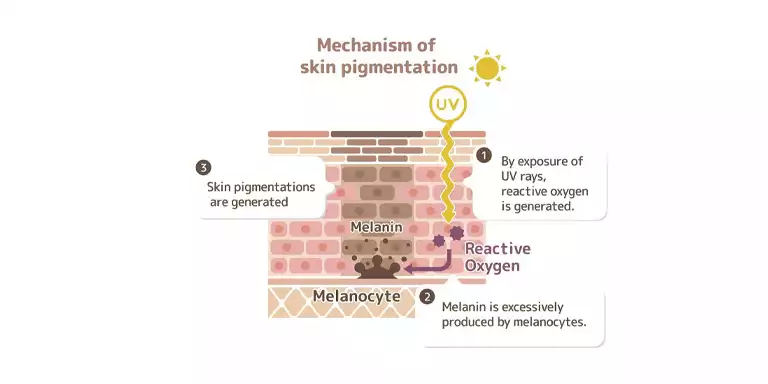
What Are Some Ayurvedic Treatments To Cure Pigmentation?
Ayurvedic Treatments have come a long way when it comes to relieving a patient from certain problems. Some old age remedies works wonder when it comes to the treating pigmentation. Today, let’s take a look at some Ayurvedic Treatments which can help an individual in curing Pigmentation.
(Doctors’ Circle World’s Largest Health Platform – How to treat hyperpigmentation with Ayurveda? – Dr. Mini Nair)
- Saffron – A pinch of Saffron is believed to have various anti-oxidant properties which cure pigmentation. Mix a pinch of saffron in raw milk and let it soak for half an hour. Apply it all over the face to moisturize, heal and reduce pigmentation.
- Sandalwood Powder – Sandalwood Powder is another magical ingredient which reduces pigmentation to a great extent. When mixed with honey and yogurt it forms an excellent mask which helps in reducing sun spots and discoloration.
- Manjistha – Mix 1/4th of Manjistha Powder with honey and rose water to form a paste. Apply it as a face pack and let it dry. Wash it off with regular temperature water to reap its benefits.
- Orange Peel Powder – Orange Peel Powder is an extremely useful component to lighten spots and scars. Dry an orange peel and grind it. Mix it in with some raw milk and apply it as a face pack.
- Walnut Powder – Due to its natural cleansing properties, walnut powder can be used as a gentle scrub which doesn’t cause micro tears in the skin. This in turn removes blackheads, whiteheads and stubborn sun spots.
- Jojoba oil – Jojoba Oil has various moisturizing and nourishing properties. With timely usage and incorporation in one’s daily skincare routine, the hyperpigmentation issue can reduce to a huge extent.
- Papaya – Papaya is known to impart a gorgeous glow to the skin. It contains several enzymes which help in lightening discoloration, hyperpigmentation, small bumps and scars. Mash it and apply on the face for 25-30 minutes before taking a shower. Continue applying it for 2 days in a week for an entire month and see the results.
- Potatoes – An enzyme called catecholase is present in potatoes. This particular substance is what helps in getting rid of pigmentation. Soak a cotton ball in the juice of 1 potato and apply it on the affected areas. Leave it on for 15-20 minutes and rinse it off. Do it on every alternate day for a month and see the results. This is also beneficial in getting rid of under eye dark circles.
- A blend of Coriander, Fennel and Cumin seed water – A blend of coriander, cumin and fennel seed when soaked in water is extremely beneficial for reducing pigmentation. This cools down the system as well. Soak them overnight in water. Strain and drink the concoction in the morning.
- Oils (Kumkumadi, nalpamaradi, eladi, kanaka) – The three beneficial oils, kumkumadi, nalpamaradi, eladi and kanaka have moisturizing, nourishing and healing properties in them. They are also great for lightening pigmentation over a period of time without damaging the skin.
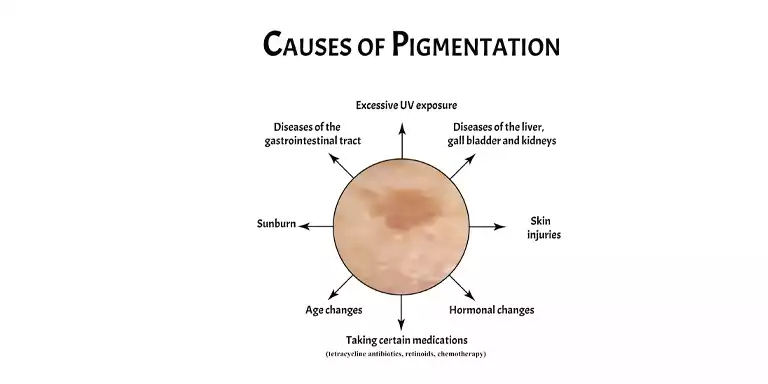
What Are The Homeopathic Treatments For Skin Pigmentation?
Homeopathic Treatments are milder, simpler and much more effective in the long run. It is different from traditional medicinal treatments as it focuses on curing the problem from its roots instead of just suppressing/curing it for the time being. It is also a great alternative solution for people who get frequent allergic triggers and are not looking to consume pills and tablets.
The case-analysis includes the medical history of a patient, along with the physical and mental constitution, genetic predisposition and more. Factors like mental stress, nutritional deficiency, poor immune system, hormonal imbalances, sun exposure etc. are all taken into consideration.
Homeopathic medicines and remedies usually restore the hormonal imbalance and control the excessive melanin production. Homeopathy doesn’t inhibit the natural process of the skin’s melanin. It controls the melanocytes to produce less melanin naturally.
This in turn strengthens the skin cells to stay healthy while removing the excessive melanin from the skin. This also improves the texture of the skin. The blemishes disappear and discoloration also stops.
Let’s take a look at some common Homeopathic Treatments which are available to treat your hyperpigmentation.
- Lycopodium Clavatum – This medicine is the perfect option for people who are suffering from blue circles around the eyes. If an individual is suffering from grayish yellow discoloration on the face then this is the treatment which one can opt for.
- Sepia offincinalis – Sepia offincinalis is an excellent option for individuals who are willing to treat chloasma and pregnancy ailments. This treatment is good for patients with dark hair. If you are suffering from a yellowish hue around the upper region of the nose and cheeks then it is a sign of chloasma. Yellow spots can also be another indication of pigmentation.
- Thuja occidentalis – Individuals who are suffering from dry skin and brown spots can opt for this particular homeopathic medicine. Patients who also have waxy faces with darker under eyes can opt for this specific medicine.
- Argentum nitricum – If your face looks pale, old, and bluish then Argentum Nitricum is the perfect homeopathic treatment for you. It also helps in treating rough, hard and brown skin with irregular blotches.
- Cadmium sulphuratum – Prolonged exposure to the wind, sun and pollution can cause a yellowish tinge on the cheeks and nose and treated with cadmium sulphuratum.
- Copaiva offincinalis – Brown lenticular spots which are also known to itch at times and give a mottled appearance can be treated with Copaiva officinalis.
- Caulophyllum thalictroides – Women who experience discoloration due to uterine issues and menstruation, can opt for this particular homeopathic medicine.
- Plumbum melallicum – Individuals who have an oily skin, liver spot and hyperpigmentation can get their problems treated with the plumbum melallicum.
- Pulsatilla Nigricans – Acne which results from irregular menstrual changes, PCOS/PCOD and other complications can often leave a mark of discoloration on the skin which can be treated with this particular medicine.
(Doctors’ Circle World’s Largest Health Platform – Best Homeopathic Treatment – Dr. V. Bhagyalakshmi)
- Berberis Aquifolium – Eruptions which occur from breakouts, acne, blackheads and whiteheads can be treated with this particular homeopathic medicine. After application your cheeks might feel a little hot, but that sensation is absolutely normal.
- Sulphur – Patients who have extremely dry skin with pigmentation are more prone to getting scarred in the long run. Homeopathic sulphur is the key solution. These are majorlly happend due to long hours exposure in sun.
- Psorinum – Oily, waxy skin can be treated with Psorinum. When an individual’s face looks dull, sick and pale it is best to opt for Psorinum. This prevents the issue of pigmentation from recurring while curing the issue from its roots.
- Lachesis Muta – Pre-menopausal women who are suffering from the problem of pigmentation can use the homeopathic medicine Lachesis Muta. Pigmentation which occurs in the shade of blue, black and purple can make the skin look severely discolored. This is when this homeopathic remedy comes to the rescue.
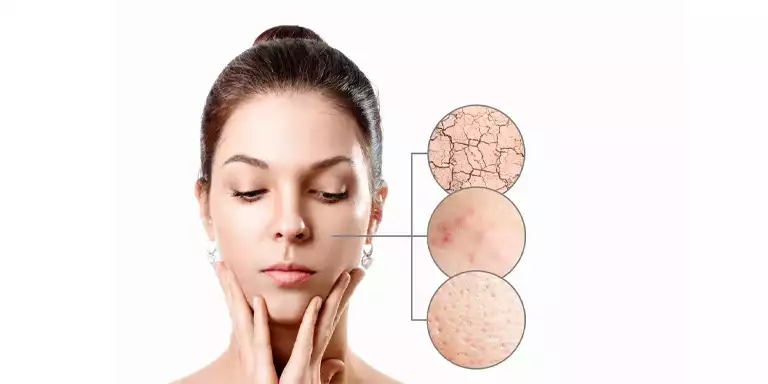
What Are The Lifestyle Changes For Decreasing Pigmentation?
There are various lifestyle changes which one can do in order to decrease pigmentation. These little daily habits when incorporated into our everyday lifestyle can protect the skin which can further delay the skin from maturing/aging/going dull on a rapid basis.
This includes checking your water consumption, investing in a good skincare, timely visits to the dermatologist and so on. Let’s look at simple steps which curb the problem of pigmentation without much external treatment.
- Keep yourself hydrated – Keeping yourself hydrated is one of the most important factors of keeping pigmentation at bay. Especially in the summer seasons, stock up on plenty of green juices, fresh juices and vegetables. The higher your water content is, the better your body will function while keeping sun spots and tanning away.
- Invest in a good skin care routine – A good skincare routine will make sure that your skin doesn’t crack, peel or dry up in cases of extreme tanning and discoloration from the heat, dust and pollution. Follow a timely routine in the morning and before bed time to keep your skin healthy and nourished for a long time.
- Visit a dermatologist – A routine checkup to the dermatologist will ensure that your skin issues are treated on a timely basis. This will also treat acute pigmentation and any other problems that one might be facing which usually isn’t solvable by an OTC ointment or home remedy.
- Add Green Tea to your diet – Adding Green Tea to your diet is a great way to incorporate some antioxidants. It also contains anti-inflammatory properties which is a great addition to prohibit the issue of pigmentation.
- Use Sun Protection – Using a good sun protecting cream or lotion with an SPF of 30 and above is extremely useful to avoid pigmentation on a regular basis. Apply a moisturizer according to your skin type and layer it on with a good quality sun protecting lotion. Re-apply after every 2-3 hours to reap its maximum benefits.
- Add seasonal fruits and green leafy vegetables to your diet – A nutritious diet filled with green leafy vegetables and plenty of fruits will keep your skin hydrated, healthy and nourished from within which will give it a natural glow.
- Use DIY face masks – Combine a variety of fresh ingredients like turmeric, aloe-vera potatoes, bananas and strawberries in varying proportions to form a facial mask. This reduces the production of melanin which in turn combats hyperpigmentation and discoloration.
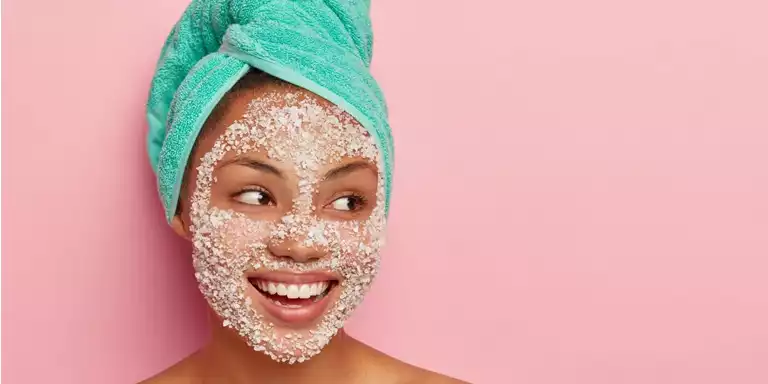
Water Consumption For Skin Pigmentation
Water consumption is an important aspect for treating pigmentation. Hard or polluted water create hindrance in solving this issue. This is due to the rising levels of harmful components like mercury, lead and other radioactive substances.
Washing your skin and hair with clean water is a major and important step to combat the issue of pigmentation. Spots, discoloration and dry skin are all hugely dependent on the type of water that one is using.
No scientific evidence found that copper-infused water helps in lighted Vitiligo patches.
If you are one of those individuals who forget to drink water on a timely basis, then incorporate the goodness of coconut water in your diet. This simple yet effective solution cools down the body while giving the skin a natural and healthy flushed glow.
Drinking plenty of water also prevents your body temperature from rising and heating up uncontrollably. This in turn, prevents any sun spots and acne eruptions which can leave a stubborn mark. Hyperpigmentation and discolorations only controlled when you have healthy skin and gut which eventually means drinking at least 2-3l of water every day.
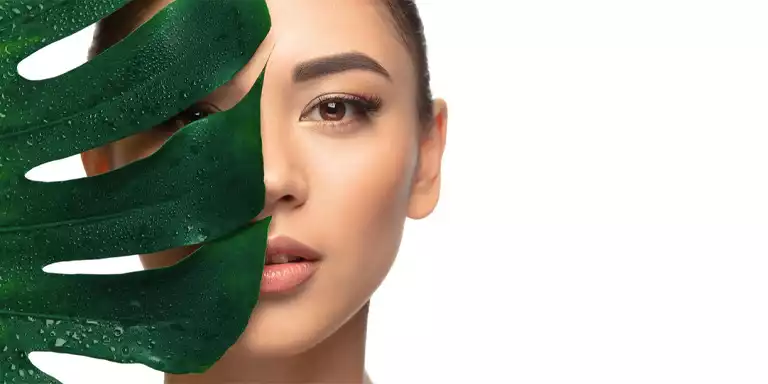
Case Studies For Skin Pigmentation –
Physiological Factors which regulate skin pigmentation – National Library of Medicine
- Hyperpigmentation – A case study
- Hyperpigmentation Therapy: A Review
- Skin Hyperpigmentation in Indian Population: Insights and best practice –
- Understanding and tackling common issues for skin color

How To Select The Best Parlor For Pigmentation Treatment?
While an increase in temperature creates a rise in the issue of Pigmentation, this pesky skin condition can occur at any time of the year. Fortunately, help is available at hand through various cosmetic and skin treatments in a wide range of spas and parlors.
Different pigmentation types require different solutions although there is a general rule when it comes to choosing the best treatment. Parlors all over the globe are upping their game when it comes to skincare.
Pigmentation falls under the wide umbrella of both makeup and skincare. When it comes to selecting the best parlor for pigmentation treatment a host of options are available although one type may not suit all.
Go for a consultation with a dermatologist beforehand to map out your skin type, seriousness of the issue and an overall idea about the kind of service which will help you to get rid of the issue via a fast route.
Before going to the parlor and choosing a random treatment make sure to thoroughly research regarding the process and talk in advance with the beautician.
Make sure to follow up regarding the pre and post care process. Due to it’s important role make sure your treatment lasts with visible effects.
If any of these services are available in your parlor then go for it.
- Chemical Peels – Chemical Peels are one of the most effective ways to reduce patches, blotchy skin and hyperpigmentation. These peels are often unsafe if done incorrectly at home as it can cause long term damage and in some rare cases partial blindness. It’s best to take this treatment from an expert. Who will examine your skin type and required peel beforehand. This also reduces the chances of any rashes, irritation or breakouts.
- Micro needling – Micro Needling is another cosmetic treatment which was popularized by socialite and beauty mogul Kim Kardashian. Also known as the vampire facial, this treatment includes drawing the patient’s blood in a syringe and spinning it in a centrifuge. Known as the PRP (Platelet Rich Plasma) therapy. This treatment is very effective as it improves wound healing, skin elasticity, volume, texture and hyperpigmentation.
- Mesotherapy – The technique of Mesotherapy uses a very fine needle to deliver a series of injections into the middle layer (mesoderm) of skin. The idea behind using mesotherapy to treat the problem of pigmentation is that it corrects underlying issues like poor circulation and inflammation of the skin. This technique uses injections of vitamins, enzymes, hormones, and plant extracts to rejuvenate and tighten skin.
- Facials – In order to treat hyperpigmentation, any regular facial might not just do the job. Brightening, lightening and glowing facials are the ones to check out for, in order to reverse discoloration and fade away stubborn sun spots.
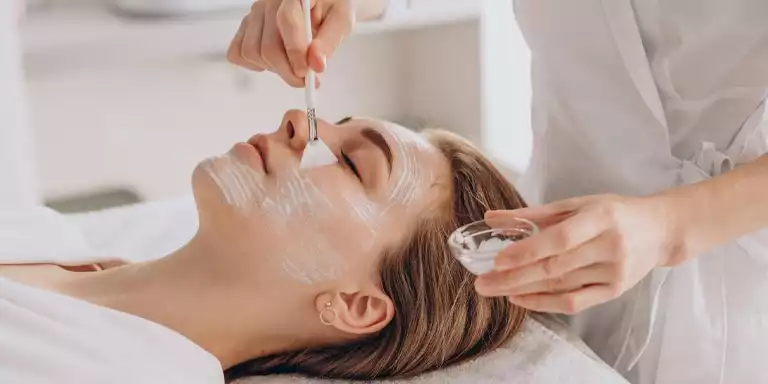
What Are The Different Types Of Facials To Get Rid From Skin Pigmentation?
Our hectic and stressful lifestyle has led to various problems that disrupt the natural healing process of the largest organ in our body – skin. Pollution, long working hours, unhealthy eating habits, smoking, alcohol consumption and various other factors can lead to the contribution of pigmentation and discoloration. To achieve a glowing, spotless skin it is essential to follow up on facials on a timely basis. This is also effective for people who have age spots, dull and dry skin and fine lines.
- Gold Facial – Used by Romans and Egyptians since the beginning of time, a gold facial has found its popularity in current times in the form of a concentrated facial. This reduces fine lines, blemishes, wrinkles, marks and discoloration. It also helps in overall cell growth and renewal.
- Brightening Facial – A brightening facial rejuvenates, brightens, nourishes and helps in reducing pigmentation, especially around the mouth and eyes. It specifically targets hyperpigmentation and helps in evening out the skin tone. Usage of products like Vitamin-C boosts radiance and brings back the natural glow of the skin. One can notice a drastic change in their hyperpigmentation after just 2-3 sessions of a brightening facial.
- Fruit Facial – A Fruit facial is considered to be one of the best options for your skin. The fruit acids agents are very heplful in exfloation and removing dead cells from skin, cleaning clogged pores lighten and brighten the skin. Fruit facials are good options in improving texture and tone of skin.
- Gem/Crystal Infused facial – Gems and crystals like diamonds are used for exfoliation in order to remove blackheads and clean out any additional dirt, debris and pollution from the skin. This exfoliates the skin on a thorough basis due to which the results last longer as compared to a regular facial. This facial removes tan, dark patches and keeps the melanin production in check. It adds a youthful radiance and glow in just one session.
- Vitamin Facial – A vitamin based facial is beneficial for pigmented and dry skin as it removes dark spots, tan lines, dullness and lightens them with timely usage. A multi-vitamin(A,C &E) facial is extremely useful for soft, supple, glowing and blemish free skin.
- Floral Facials – Enriched with the goodness of flowers, a floral facial can work wonders for a pigmented skin. It brightens uneven tones and clears out the skin. Flowers like rose, marigold and lotus hold the key to a fresh and radiant skin. Apart from reducing discoloration and spots it also improves skin clarity by lightening any previous acne scars and marks.
Conclusion
In conclusion, pigmentation can have various different causes and reasons. While some factors are completely hereditary, other symptoms might include various deeper medical issues. They can pose a threat to an individual’s life if untreated for a long time.
Pigmentation can also show up on our face in the form of dark circles, blueish-black hue near the mouth, sun spots, uneven brown patches and a yellowish hue in some cases of jaundice. In treating pigmentation, some simple lifestyle changes can also play a big role.


